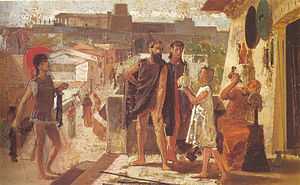Federico Faruffini

Federico Faruffini (Sesto San Giovanni, 1831- Perugia, 1869) was an Italian painter and engraver of historical subjects, in a style that combines the styles and themes of Realism with the diffuse outlines and lively colors of Scapigliatura painters.
Biography
Born in Sesto, a commune now inside the metropolitan area of Milan, he initially trained with Trecourt in Pavia. He befriended Tranquillo Cremona and accompanied him to Milan and Venice. He traveled with Giovanni Carnovali. In the 1864 exposition at the Brera, he submitted a watercolor, Coro della Certosa di Pavia and four oil canvases, Scholars of Alciato, an Annunciation, Cordello e Cunizza, and his Macchiavelli and Borgia, which he both painted and engraved, and for which he obtained a medal in 1866. His Sacrifice at the Nile was painted for the 1865 exhibition. In 1867, at the Salon exhibition in Paris, he was awarded a first prize medal for a paintings of Borgia and one of The death of Ernesto Cairoli.[1]
Lack of recognition and financial difficulties is said to have led him to commit suicide at age 38.
Gallery
-

Ponte Sant'Angelo. -

The Reader. (?) -

Titian's Gondola. -

Sacrifice of the Virgin to the Nile.
References
- Norman, Geraldine (1977). Nineteenth Century Painters and Painting: a Dictionary. University of California Press, Berkeley and Los Angeles. p. 82. ISBN 0-520-03328-0.
- ↑ La Pittura lombarda nel secolo XIX., Tipografia Capriolo e Massimino, 1900, page 68.
This article incorporates text from the article "FARUFFINI, Federico" in Bryan's Dictionary of Painters and Engravers by Michael Bryan, edited by Robert Edmund Graves and Sir Walter Armstrong, an 1886–1889 publication now in the public domain.
| Wikimedia Commons has media related to Federico Faruffini. |